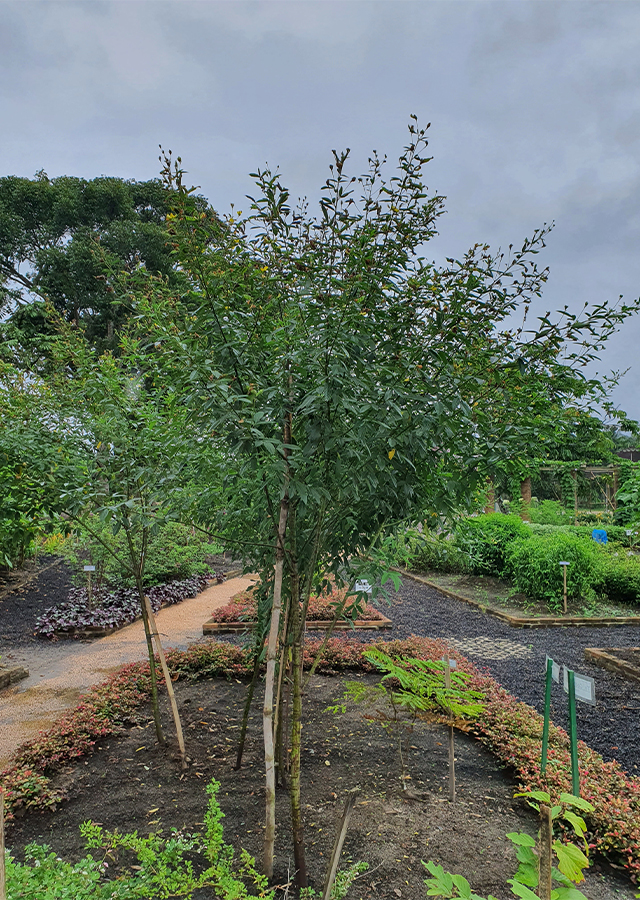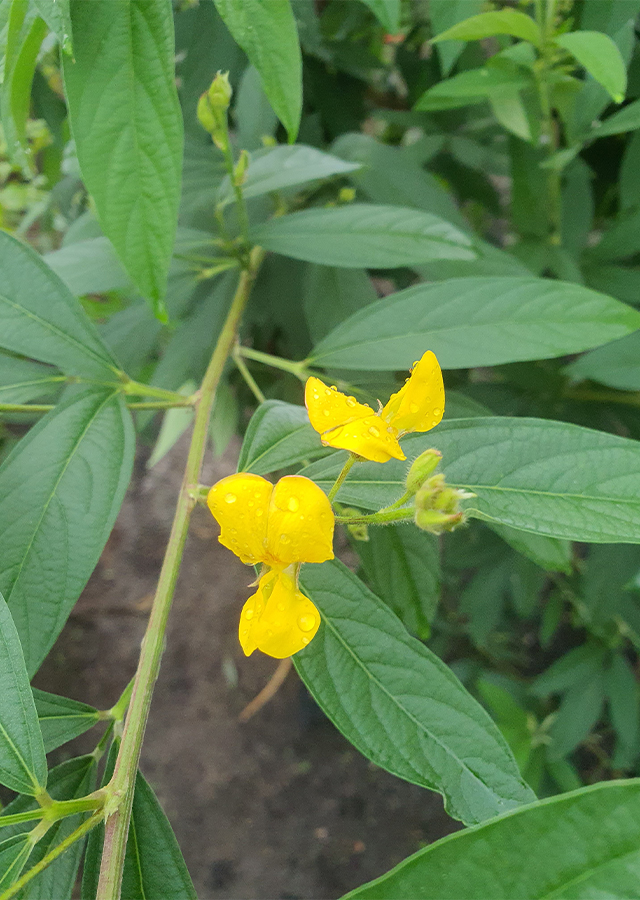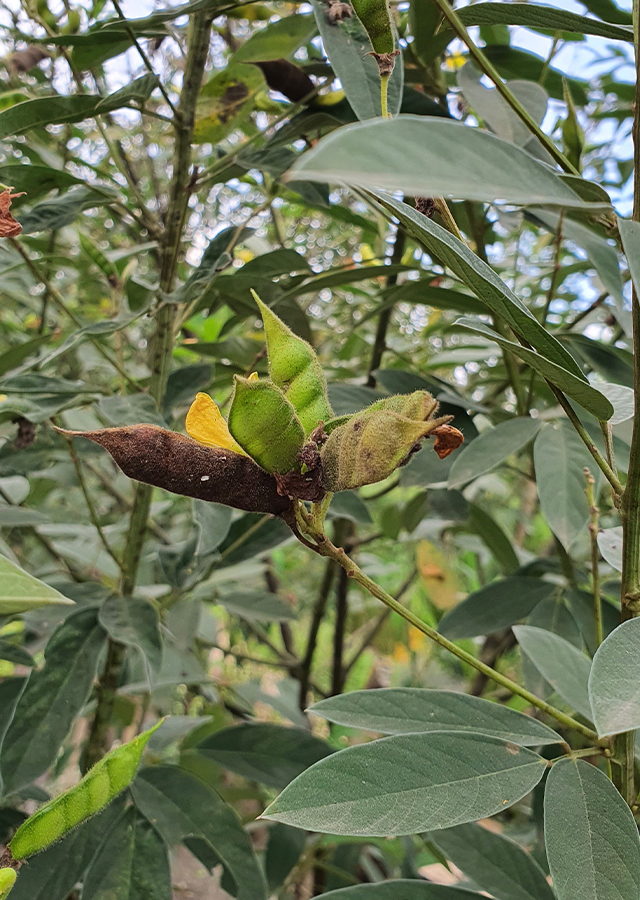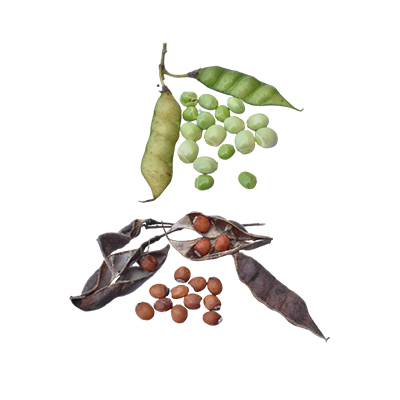Pigeon pea
Cajanus cajan (L.) Huth
Fabaceae
Location in our garden
Vegetable



Synonym
Cajanum thora Raf.
Cajanus bicolor DC.
Cajanus flavus DC.
Habitus
Shrubs. An erect, glandular-pubescent, branched, short-lived perennial shrub, 0.5 – 4 m high usually 1–2 m high
Part Used
Leaves
Seeds
Roots
Stem
Growing Requirements
Full Sunshine
Drought Resistant
Habitat
Shrublands
Grassland
Overview
Pigeonpea originated in India and spread to South-East Asia in the early centuries and appeared around 2,000 BC in West Africa, which is considered a second major center of origin. It is widely cultivated in the tropical and subtropical regions in Asia, Africa, the Pacific, and the Atlantic. It is grown all over the tropics, the most important in the Indian subcontinent and East Africa.
Vernacular Names
Pigeonpea (English), Mu dou (Chinese), Pois d'Angole, Ambrévade (French), Kacang dhal (Malaysia), Tabois (Philippines), Pijonpii (Japanese), Cay dau chieu (Vietnamese), Thwàx h'ê (Laos), Cachito (Spanish), Straucherbse (German), Kacang gude (Indonesia).
Agroecology
This plant grows well in lowland tropical areas up to an elevation of 1,500 m, though some forms can still do well up to 2,000 m. It generally prefers a rainfall in the region of 500-1,000 mm per year, though there are some cultivars that are adapted to wet, humid tropics so long as the soil is well-drained. Also grows best in a sunny position.
Morphology
- Roots - nodulated up to 2 m deep.
- Stem - ribbed and up to 15 cm in diameter and with many slender pubescent branches.
- Leaves - alternate, trifoliolate, glandular punctuate on 1.5–5 cm long petioles.
- Flowers - axillary in pseudoracemes, sometimes concentrated and synchronous (determinate), usually scattered and flowering over a long period (indeterminate), papilionaceous, corolla yellow or cream, standard dorsally red, orange or purple.
- Fruits - a straight or sickle-shaped, green or red depending on variety, linear-oblong legume, 2–13 cm long by 0.5–1.7 cm wide with subglobose to ellipsoid or squarish seeds.
- Seeds - white, cream, brown, purplish to almost black, plain or speckled, 5 mm in diameter.
Cultivation
Propagated by seeds - sow in situ during the wet season, placing the seed 2-3 cm deep in the soil, germinating at temperatures of 19-43 °C, but most rapidly at 20-30 °C.
Chemical Constituents
Flavonoids, saponins, polyphenol, tannins, alkaloids, cyanogenic glycosides, anthoxyanin, cajanin, anthraquinone glucoside, genistein, longistylin.
Traditional Medicinal Uses
- Roots are considered anthelmintic, expectorant, febrifuge, sedative, vulnerary.
- Studies have suggested antihyperglycemic, anti-inflammatory, anti-plasmodial, anti-sickling, antihyperlipidemic, antimicrobial, anticancer, antioxidant, antifertility, biosorbent, antiulcer, neuroprotective, hepatoprotective properties.
- Leaves are used in the treatment of measles, rheumatism, infected burn wounds, bedsores.
- Decoction or infusion of leaves is used for coughs, diarrhea, abdominal pains.
- Tender leaves are chewed for aphthous stomatitis and spongy gums.
- Pulped or poulticed leaves are used for sores.
- Roots are chewed for toothache; leaves are used to clean teeth.
- In Peru, leaves are used as an infusion for anemia, hepatitis, diabetes, urinary infections, and yellow fever.
- In Argentina, leaves are used for genital and skin problems; flowers are used for bronchitis, cough, and pneumonia.
- In China, as vermifuge, vulnerary; for tumors.
- In Panama, used for the treatment of diabetes and jaundice.
- In Bangladesh, used for the treatment of diabetes.
Part Used
Reference Sources
- Lim, T.K. (2012). Edible Medicinal And Non-Medicinal Plants: Volume 2, Fruits. New York, Springer. pg549.
- Pal, D., Mishra, P., Sachan, N., & Ghosh, A. K. (2011). Biological activities and medicinal properties of Cajanus cajan (L) Millsp. Journal of advanced pharmaceutical technology & research, 2(4), 207.
- StuartXchange. (2016). Philippine Medicinal Plants. Kadios. http://www.stuartxchange.org/Kadios.html. 02-02-2021.
- Tropical Plants Database, Ken Fern. (2014). Cajanus cajan. http://tropical.theferns.info/viewtropical.php?id=Cajanus+cajan. 2021-11-29.
- Van der Maesen, L.J.G. (1989). Cajanus Cajan in L.J.G. van der Maesen, L.J.G & Somaatmadja, S. (eds.). PROSEA: Plant Resources Of South-East Asia, No.1: Pulses / PROSEA. Netherlands: Wageningen Pudoc.



